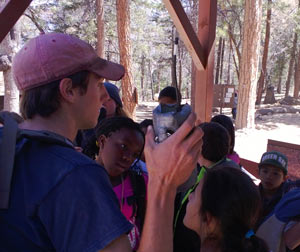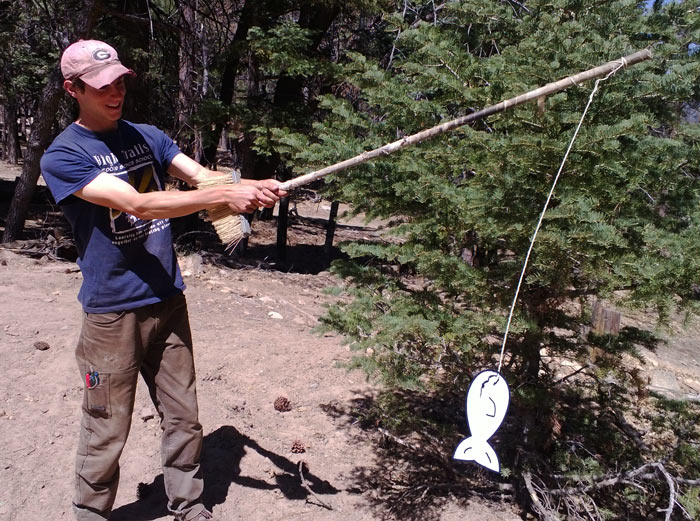 I hold up my radio and beckon to the kids in the back, urging them to listen to the crackly voice emanating from the speaker.
I hold up my radio and beckon to the kids in the back, urging them to listen to the crackly voice emanating from the speaker.
It’s almost time for switchover, when the kids will join their field instructors for the day, and all the cabin groups are clumped in the open area in front of the dining hall. Chris, the site director, is addressing everyone at the same time.
“Okay everybody, point to the person who is responsible for your well-being today.”
 All of my kids point to me, and I feign surprise. Chris’s voice returns.
All of my kids point to me, and I feign surprise. Chris’s voice returns.
“If you’re pointing to yourself, you’re right!”
Most of the kids are taken aback, and understandably so. Even though they’re almost teens, many of our students are not used to caring for themselves. Because, at High Trails, they are forced to do most things for themselves, they learn how to be self-reliant.
This idea is the essence of big-picture lesson #3: You are the master of yourself.
 As substitute parents for the week, we notice with delight when our students watch out for their own well-being; many are wonderfully self-reliant. It is also (often painfully) apparent when kids do not know how to do things for themselves. The first day and night are especially rough. Instead of putting on the jacket in their backpack, many simply complain of being cold. Others, when thirsty at dinner, hold up their empty cup instead of using the water jug at their table to refill it themselves. Once I even had to teach a sixth grader how to tie his shoes. “It’s not their fault,” I say to myself over and over.
As substitute parents for the week, we notice with delight when our students watch out for their own well-being; many are wonderfully self-reliant. It is also (often painfully) apparent when kids do not know how to do things for themselves. The first day and night are especially rough. Instead of putting on the jacket in their backpack, many simply complain of being cold. Others, when thirsty at dinner, hold up their empty cup instead of using the water jug at their table to refill it themselves. Once I even had to teach a sixth grader how to tie his shoes. “It’s not their fault,” I say to myself over and over.
However frustrating these moments may be to us instructors, it is these same moments that contain incredible potential for growth.
Therefore, it is indescribably important for us to give guidance and a helping hand rather than harsh words or strikes.
- When a kid’s clothes cover every square foot of the cabin’s floor, it is our responsibility not to yell at him to clean up, but to help him become more organized.
- When a kid doesn’t know how to zip up his jacket, we must teach him how.
We cannot fall victim to the thinking that all of our teaching is done from lesson plans. Along with patience and understanding comes the equally difficult ability to let kids fail, many times if need be. The first few times they fill their own cup, more water will end up on their plate than in their glass. That’s okay. Try, try again, for that’s how they learn. By Friday, water ends up in the glass, layers are put on and zipped without complaint, and everyone is happier.
The old saying of “teach a man how to fish, feed him for a lifetime” is woefully apparent.

The simple feat of watching out for their own well-being is novel for many of our students. With some guidance from their instructors, the skills they learn at High Trails can serve them for life.
Although this blog is the last in the series about big-picture lessons, there are countless more benefits that come from environmental education, both in and out of our dirty classroom, that I have not addressed. These benefits, big-picture lessons included, are why we at High Trails work tirelessly to make sure that each student’s experience is as fun, safe, and educational as possible.
3 Part Series!
This is just one part of a three part series. Read them all. Because Danny rites vary well.
Introduction
Part 1 is cool.
Check out Part 2.
Here’s Part 3.
At High Trails Outdoor Science School, we literally force our instructors to write about elementary outdoor education, teaching outside, learning outside, our dirty classroom (the forest…gosh), environmental science, outdoor science, and all other tree hugging student and kid loving things that keep us engaged, passionate, driven, loving our job, digging our life, and spreading the word to anyone whose attention we can hold for long enough to actually make it through reading this entire sentence. Whew…. www.dirtyclassroom.com

Comments are closed.